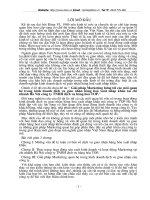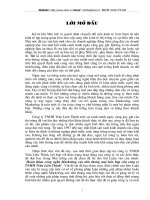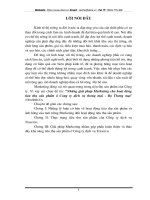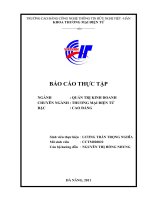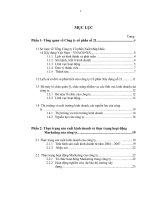Some digital marketing solutions for appota joint stock company = Một vài giải pháp Digital Marketing cho Công ty CP Appota
Bạn đang xem bản rút gọn của tài liệu. Xem và tải ngay bản đầy đủ của tài liệu tại đây (2.4 MB, 87 trang )
VIETNAM NATIONAL UNIVERSITY,
HANOI SCHOOL OF BUSINESS
TRAN VINH QUANG
SOME DIGITAL MARKETING SOLUTIONS FOR APPOTA
JOINT STOCK COMPANY
Major: Business Administration
Code: 60 34 05
MASTER OF BUSINESS ADMINISTRATION THESIS
Supervisors: Dr. Tran Doan Kim
Hanoi - 2012
vii
TABLES OF CONTENTS
AKNOWLEGEMENT i
ABSTRACT ii
TÓM TẮT iv
TABLES OF CONTENTS vii
LIST OF TABLES AND FIGURES x
ABBREVIATIONS xi
INTRODUCTION 1
1. CHAPTER 1 - LITERATURE REVIEW 4
1.1 Overview of marketing 4
1.1.1 Marketing in general 4
1.1.2 Marketing management 4
1.1.3 Shift in marketing management 6
1.2 Digital Marketing 7
1.2.1 Definition 7
1.2.2 The advantages and disadvantages of digital marketing 8
1.2.3 The factors that influence in Digital marketing 10
1.3 Majors marketing tools in digital marketing 12
1.3.1 Email marketing 12
1.3.2 Online advertising 15
1.3.3 Affiliate marketing 18
1.3.4 Viral marketing 20
1.3.5 Social media marketing 22
1.3.6 Search engine marketing 26
1.3.7 Mobile marketing 29
2. CHAPTER 2 - ANALYSIS OF DIGITAL MARKETING SITUATION OF
APPOTA JSC 34
2.1 APPOTA‟s introduction 34
2.1.1 General information 34
viii
2.1.2 Products and services 37
2.1.3 Customers 38
2.2 Digital marketing macro-environment analysis 40
2.2.1 Legal – political environment 41
2.2.2 Economics environment 42
2.2.3 Social – cultural environment 42
2.2.4 Technological environment 43
2.3 APPOTA‟s Digital Marketing situation analysis 49
2.3.1 Company factors influencing marketing activities 49
2.3.2 Market factors and trends 50
2.3.3 Future competitors and Appota analysis 501
2.3.4 Current major marketing tools 514
2.4 Evalution of Appota‟s digital marketing 60
2.4.1 Pros 60
2.4.2 Cons 62
3. CHAPTER 3 – SOME DIGITAL MARKETING SOLUTIONS FOR APPOTA
JSC 63
3.1 Recommended in major digital marketing tools 63
3.1.1 Online advertising 63
3.1.2 Social media marketing 63
3.1.3 Viral marketing 65
3.1.4 Mobile marketing 66
3.1.5 Market research 67
3.1.6 Management process 67
3.2 Action plan 68
3.2.1 Action plan for each step 68
3.2.2 Budget and other resources 69
3.2.3 Schedule 70
3.2.4 Control and Evaluation 70
3.3 Other suggestions for company 70
ix
3.3.1 Differentiation-Focus to market segment 70
3.3.2 Focus in product‟ development and innovation 71
3.3.3 More suggestions to improve 72
4. CONCLUSION 77
REFERENCE 79
APPENDIX 1 SAMPLES OF WEEKLY CONTENTS PROVIDED TO APPOTA
USERS 80
x
LIST OF TABLES AND FIGURES
FIGURE 1-1: CONTEX OF DIGITAL MARKETING 10
FIGURE 1-2: THE SONG‟S TREND IN GOOGLE TREND 21
FIGURE 1-3: THE MODEL OF SOCIAL MEDIA 23
FIGURE 1-4: THE MODEL OF WEB 2.0 24
FIGURE 1-5: RELATED WORD IN SEARCHING 27
FIGURE 2-1: APPOTA‟S MAJOR MILESTONE: 35
FIGURE 2-2: APPOTA‟S BUSINESS MODEL 36
FIGURE 2-3: VIETNAM SMARTPHONE OPERATING SYSTEM SHARE 38
FIGURE 2-4: APPOTA‟S USERS BY MOBILE PHONE OPERATING SYSTEM
39
FIGURE 2-5: APPOTA‟S TOP & BIGGEST APPLICATION DEVELOPERS
AND CONTENT PROVIDERS 40
FIGURE 2-6: IT INDUSTRY - REVENUES AND GROWTH RATE 42
FIGURE 2-7: INTERNET USERS - NUMBERS AND GROWTH RATE 45
TABLE 1-1: PROS AND CONS OF ONLINE ADVERTISING 17
TABLE 1-2: COMPARING BETWEEN TRADITIONAL MEDIA AND SOCIAL
MEDIA 22
TABLE 1-3: SEARCH ENGINE MARKETING – SEO & PPC‟ PROS AND
CONS 28
TABLE 1-4: MOBILE PHONE FEATURES AND IMPLICATION FOR
MARKETERS 30
TABLE 2-1: NUMBER OF TELECOM, INTERNET SERVICE PROVIDERS 47
xi
ABBREVIATIONS
2G 2nd Generation Mobile System (usually GSM)
3G 3rd Generation Mobile System (usually UMTS/WCDMA)
SME Small and Medium Enterprise
MI Mobile Internet
SP Service Provider
CS Content supplier
DEV Developer
CP Content providers
TELCO Telecommunication Company
NO Network Operator
ISP Internet Service Provider
ADV Advertising
HR Human Resource
IP Internet Protocol
ADSL Asymmetric Digital Subscriber Line
MBA Master of Business Administration
LAN Local Area Network
R&D Research and Development
ROI Return on Investment
SWOT Strengths, Weaknesses, Opportunities and Threats
SMS Short Messaging Service
IOS Apple mobile operating system
Android Google mobile operating system
FI Founder Institute
Mobile website A website that programed to compatible with mobile device
ARPU Average Revenue Per User
1
INTRODUCTION
1. The thesis title
Some Digital Marketing Solutions for APPOTA Joint Stock Company
2. Purpose
The purpose of this thesis is to suggest some marketing solutions with action
plans to be used in a year to continue growth of Appota with existing products.
In order to do that, the thesis focuses on reviewing and summarizing the theory
of marketing and digital marketing with major tools; applying the reviewed
literature to analyze Appota situation now; and propose some solutions to enhance
the digital marketing in Appota.
3. The thesis necessity
Appota is a SME (Small and Medium Enterprise) in the information and
communication technology founded in Dec, 2011. Within a year of start-up, it has
achieved a significant growth in terms of both revenues and headcount.The
company currently has employed more than 60 headcount who obtain many years
of experience in mobile content. Appota has become a premier partner to many big
companies in the same industry and a leading-edge smartphone content provider in
Vietnam. With the market share of more than 60% of smartphone users including
iOS and Android mobile users, Appota is one of the most disruptive start-up in
Vietnam ICT industry. The company intends to increase its market share to be the
dominance and keep the impressive growth to extend business to South East Asia
with the target of coverage over 20 million smartphone users.
Being one of the co-founders of the company and take responsible for all sales
& marketing activities, I have been working with both Sales& Marketing team to
gain market share, attract customer, monetized products and services, build
customer database, keep strong relationship with partners We have tried a lot of
new marketing strategies or plans to find the best approach for the company. Based
on the research in marketing activities and with an insight of company situation, my
2
finding in this thesis is to address the digital marketing with specific solutions as a
strong tool for the company to keep the growth.
4. Scope of research
APPOTA follows a new model in Vietnam with no competitors currently,
moreover it has only one year of operation. Therefore, instead of implementing
industry analysis (including competitors) and SWOT analysis (that provides
understanding about Strengths, Weaknesses, Opportunities and Threats) the thesis
focuses on suggesting some practical solutions for the company.
This thesis offers an idea for the company on how they could apply the
marketing solution, especially eMarketing to keep the growth of market share and
growth of customer base in the target segment.
5. Research questions
1. Which theories can be applied in Digital Marketing at Appota?
2. What current digital marketing practice at Appota?
3. How to improve Digital Marketing and other suggestion to Appota?
6. Methodology and Limitations of Study
The thesis based on a qualitative research and a case study method for analytical
purpose to suggest or explain why or how something is happening.
Appota‟s specific data collection was carried out by interviews. In the
interviews, Appota‟s representatives like CEO (Chief Executive Officer), CMO
(Chief Marketing Officer) and Product Director provided very valuable ideas and
information on the subject.Besides, author‟s own observations and experiences were
also used in data collection and analysis. Secondary data has been computed by
research of documents, annual/quarterly reports of Appota.
7. Significance
By reviewing the theory of digital marketing, this research benefits Appota in
proposing marketing tools to increase the market share and improve the revenues
which contributes to the company‟s development.
3
8. Expectation
Digital marketing is being well applied in many companies around the world so
the same methodology can be applied in the scenario of other companies in the
same industry with some adjustments.
9. Follow-up
Further study will be carried on upon the result of this thesis in applying some
digital marketing solutions for the company. Other way of study will be analyzing
the impact of the competition on the company and steps toavoidor come over
unexpected impacts
10. Structure
The first chapter is an introduction with concentration on marketing in general
and marketing tools, especially digital marketing.
The second chapter describes actual state of the company regarding its products
and services, customers and current marketing practice.
The third chapter concentrates on marketingsolutionsfor the company with a
specific action plan.
4
1. CHAPTER 1 - LITERATURE REVIEW
1.1 Overview of marketing
1.1.1 Marketing in general
Marketing can be found everywhere as people nowadays are bombarded with
television commercials, direct-mail offers and sales calls. Simplified, marketing is
only a two-way process, even though four stages can be recognized which are
designing, developing, delivering and determining value
1
. Baines stresses that a
two-way process includes customer and marketing organization. The four stages are
there to ensure that the whole process will be successful. Customer is the one who
has the power to make the final decision and has a strong input. Additionally,
marketers must specify how to satisfy customers‟ needs.
In Vietnam, perspective to marketing is very different. They emphasize the
importance of market segmentation and positioning instead of other features. As can
be seen, marketing is a wide and versatile term, which includes many dimensions of
business activities. Whatever determination is used, the terms value, customer needs
and information are often mentioned. Therefore, when thinking of promotion, which
is a vital part of the marketing process, it is good to bear in mind that many features
influence the result.
1.1.2 Marketing management
Marketing deals with identifying and meeting human and social needs. When
YouTube realizes that people want to share their video and interact in a simple way,
or when WhatsApp realized that people want to chat via mobile phone‟s data plan
rather than to pay money for SMS, they demonstrated marketing savvy and turned a
private or social need into a profitable business opportunity. It is the reason why
marketing is also defined as “meeting needs profitability”.
1
Baines, Fill, Page, “Marketing: Case insight”,Oxford University Press, 1
st
edition, 2008, pg.17
5
Based on that concept, there is a formal definition about Marketing provided by
American Marketing Association:
“Marketing is an organizational function and a set of processes for
creating, communicating, and delivering value to customers and for
managing customer relationship in ways that benefit the organization and its
stake holders”.
2
“Marketing management is defined as the art and science of choosing
target markets and getting, keeping, and growing customers through
creating, delivering and communicating superior customer value.”
3
Marketing management consists of important tasks
4
:
Developing marketing strategies and plans, meaning to identify potential
long-run opportunities given its market experience and core competencies
Capturing marketing insightsthis step is to understand what is happening
inside and outside the company.
Connecting with customersthis task is to consider how to best create value for
the chosen target markets and develop strong, profitable, long-term relationships
with customers.
Building strong brand: It requires the company to understand the strengths and
weaknesses of the brand with customers, define its value to bring to the customers
in considering its position in the market and anticipating its competitors‟ move
Shaping the market offerings: Define the value package the company wants to
offer to its customers
Delivering value: It is to determine how to properly deliver the value embodied
by the products and service to the target market.
2
Philip Kotler and Kevin Keller, “Marketing Management”, Pearson Prentice Hall, 12
th
edition, 2006, pg.5
3
Philip Kotler and Kevin Keller, “Marketing Management”, Pearson Prentice Hall, 12
th
edition, 2006, pg.5
4
Philip Kotler and Kevin Keller, “Marketing Management”, Pearson Prentice Hall, 12
th
edition, 2006,
pg.29-30
6
Communicating value: This task is to adequately communicate the value
embodied by the products and service to the target market. Marketing
communications activities are the means by which the company endeavors to
inform, persuade and remind customers – directly or indirectly about the brand it
sells.
Creatinglong-term growth: This step considers a long-term view of company‟s
products and services, and how profits should be grown.It get involvements of
initiating new products or services, organizing marketing resources and maintaining
a process to implement and control the marketing plan to ensure the efficiency and
effectiveness of marketing activities and how both could be improved.
1.1.3 Shift in marketing management
Philip Kotler & Kevin Keller stated 14 major shifts in marketing management in
the 21
st
century:
From Marketing does marketing to Everyone does marketing
From organizing by product units to organizing by customer segments
From making everything to buying more goods and service from outside
From using many suppliers to working with fewer suppliers in a “partnership”
From relying on old market positions to uncovering new ones
From emphasizing on tangible assets to emphasizing on intangible assets
From building brand through advertising to building brand through performance
and integrated communications
From attracting customers through stores and salespeople to making products
available online
From selling to everyone to trying to be the best firm serving well-defined target
markets
From focusing on profitable transactions to focusing on customer lifetime value
From a focus on gain market share to a focus on building customer share,
meaning instead of increasing market share, companies aim to capture a larger
7
share of customer‟s stomach by providing variety of choices to existing
customers.
From being local to being “GLocal” – both global and local
From focusing on financial scorecard to focusing on marketing scorecard
From focusing on shareholders to focusing on stakeholders
Those theoretical above shift from doing marketing with traditional channel or
method to modern method with higher reach, effectiveness and cost-saving to
digital marketing because of it scaling, extendable, un-limited reaching
1.2 Digital Marketing
1.2.1 Definition
Thanks to the booming of internet, digital marketing has appeared and gained an
accelerate growth.
Digital marketing definition can be found in various approaches. For example,
Business Dictionary defines “Digital marketing is the promotion of products or
brands via one or more forms of electronic media. For example, advertising
mediums that might be used as part of digital marketing strategy of a business could
include promotional efforts made via the Internet, Social Media, Mobile Phone and
Electronic billboards, as well as via digital and television and radio channels
”
5
Another definition is “Digital Marketing is the practice of promoting products
and services using database-driven online distribution channels to reach consumers
in a timely, relevant, personal and cost-effective manner”
6
There are two different forms of digital marketing:
In pull digital marketing, consumers actively seek the marketing contents,
often via web searches or opening an email, text message or web feed. Websites,
blogs and streaming media (audio and video) are examples of pull digital marketing.
5
6
Asia Digital Marketing Association:
8
In each of these, users have to navigate to the website to view the content. Search
engine optimization is one tactic used to increase activity.
In push digital marketingmarketers send a message without the consent of the
recipients, such as displaying advertisings on websites and news blogs. Email, text
messaging and web feed can also be classified as push digital marketing when the
recipients do not give permission to receive marketing messages. Push marketing is
also known as spam. Push technologies can deliver content as it becomes available
and can be better targeted to consumer demographics, although audiences are often
smaller, and creation and distribution costs are higher.
1.2.2 The advantages and disadvantages of digital marketing
There are several advantages of digital marketing that make it attractive to
marketers and become a strong marketing tool
7
.
Reach: advertisers can choose the internet marketing tool or mobile marketing
which have suitable viewers with overall marketing campaign. Technique can help
advertisers recognize and describe the portrait of readers that they want to focus on.
Low cost: The emergence of Internet has brought many benefits such as low-
cost transmission of information and communication to the large number of
recipients, the message is transmitted in many different forms such as text, images,
sounds, movies, games This considerably reduces the costs because of World
Wide Web capabilities.
Immediacy: With the interactive functions of online marketing, recipients can
respond to messages immediately, or interact directly with the object in a
message. This is the greatest advantage of online marketing compared with other
forms.
Dynamic and Creation: Internet marketing combines creative and technical
internet aspects, including design, development, advertising and sales. The online
marketing activities include search engine marketing (SEM), web display
7
9
advertising, e-mail marketing, affiliate marketing, interactive advertising, blog
marketing and viral marketing Online marketing is the process of developing and
promoting the business using online media. Online Marketing is not simply building
a website. Online marketing is a part of marketing strategy and must be a reasonable
investment.
Accessibility: Consumers can access products‟ information and conduct
transactions anywhere.Online marketing helps businesses access to a large market
well when it do not encounter time or geographic constraints like other media such
as print or broadcasting media.
Controlling: Online Marketing activities are easily monitored and evaluated.
For example, the services “Web Analytics” tracking number can access to the
internet contents and evaluate the message which is properly transmitted to the
customer's desire. As expected, online marketing is growing more powerful than
other types.
However digital marketing also has disadvantages that marketers have to be
careful when doing online marketing campaign:
Perception of the consumer, economic and social condition: Because the World
Wide Web is faceless, it can appear cold and user-unfriendly. This can leave
customers or advertisers feeling isolated and very inward. Everyone likes to
socialize and meet people, but in this case, it is quite difficult to do in business
anyway.
To be hard to control if people are lying: There is so much information on the
World Wide Web that it is sometimes hard to tell the difference between nonsense
and quality.
Information Overload: there isan intensive amount of information on the
World Wide Web including good and bad, truthful and lying one. So it is difficult
for readers to classify the kind of information. If advertisers cannot control or
handle them, they can affect the perception of consumers.
10
1.2.3 The factors that influence in Digital marketing
Technological advances give SMEs new ways to digitally connect with their
existing and potential customers. Digital marketing covers a wide range of
opportunitiesthat can be explored including email campaigns, banner advertising,
video marketing, blogging, mobile marketing, social media marketing, television
and radio. There are several factors that affect to digital marketing strategy, plan
and execution of a company.
FIGURE 1-1: CONTEX OF DIGITAL MARKETING
8
Target Market: Before a marketer decides to use digital marketing to attract
customers and increase sales, determines if and how the customers use digital
marketing to get information about products, services or topics related to company‟s
business. A company‟s digital marketing efforts must include languages and images
8
11
that reflect to the target market and resonate with them.
Budget: Businesses with limited budgets might skip digital marketing efforts
with a fear that it is out of their budget. In fact, low-cost digital marketing options
include creating a social media presence, blogging or creating marketing videos in
simple ways with computer and web camera. Options such as setting up microsites,
pay-per-click advertising campaigns and short message services often require a
larger marketing budget.
Talent: The knowledge and experience of marketing team have regarding
digital marketing influence whether or not it is incorporated it into the overall
marketing strategy. Before delving into digital marketing, it is important to know
company‟s options, how to implement digital marketing ideas and measure the
success. Normally, if company does not have a team with previous experience,
using a marketing consultant who specializes in digital media services is an
alternative.
Technology: Servers being down or browser and software issues causes banner
advertisements and websites not to be loaded, such common technology issues can
play a major role in the success of a digital marketing strategy. If a business
encounters issues frequently with its digital marketing campaigns, it may be less
likely to use digital strategies to promote the brands. Beyond technical difficulties,
companies often have to invest in equipment and services to implement their digital
marketing campaigns. For example, a company that wants to do video marketing
needs a digital camera, lights and audio recording equipment and expertise to use it,
or must pay a studio to handle the video editing and recording.
Time: Planning, implementing and monitoring digital marketing strategies
require a time commitment, which might be a problem for small business owners
who are not well-versed in marketing. Digital marketing plan requires constant
monitoring, to measure what is working and what needs to be altered.
12
1.3 Majors marketing tools in digital marketing
There is no doubt about it – the Internet has changed the world we live in. Never
before has it been so easy to access information, communicate with people all over
the world and share articles, videos, photos and all manners of media.
The Internet has led to an increasingly connected environment, and the growth
of Internet usage has resulted in declining distribution of traditional media:
television, radio, newspapers and magazines. Marketing in this connected
environment and using that connectivity to market is digital marketing or
eMarketing.
According to Rob Stokes
9
:
“eMarketing embraces a wide range of strategies, but what underpins
successful eMarketing is a user-centric and cohesive approach to these
strategies Marketing is about conversations, and the Internet has become a
hub of conversations. The connected nature of the Internet allows us to
follow and track these conversations, and provides entry points for all
parties. What follows in this book are ways of conversing with potential and
existing customers using the Internet.”
Based on Rob Stokes‟s categorizations, there are 16 tools for eMarketing.
However, in consideration of tools which are practical in Vietnam, following are
major tools being applied.
1.3.1 Email marketing
“E-mail marketing represents an opportunity to experience both the thrill of
increased customer loyalty and steady repeat business as well as the agony of
bounced e-mail, unsubscribe requests, and spam complaints”
10
9
Rob Stoke, “eMarketing – the essential guide to online marketing”, Quirk eMarketing (Pty) Ltd., 2008,
2
nd
edition, pg.4-5
10
E-Mail Marketing For Dummies, 2nd Edition by John Arnold, pg.18
13
Email marketing is a form of direct marketing which uses electronic mail as a
means of communicating commercial or fund-raising messages to an audience in its
broadest sense, every email sent to a potential or current customer could be
considered email marketing. Most of big brands often use this method to keep
relationship with their customers in all over the world.
Simply put, email marketing is a form of direct marketing which utilities
electronic means to deliver commercial messages to an audience. It is one ofthe
oldestand yet still one of the most powerful of all online marketing‟s tactics. The
power comes from the fact that it is:
• Extremely cost effective due to a low cost per contact
• Highly targeted
• Customizable on a mass scale
• Completely measurable
Email marketing is a tool for buildingrelationships with both existingand
potential customers. It should maximize the retention and value of these customers,
which should ultimately lead to greater profitability
FIGURE 1-2: SAMPLE OF EMAIL MARKETING
11
11
Author‟s received in personal mail box
14
Applying email marketing will help marketers make long relationship with
customers. It can create many competitive advantages as:
Enhancing the relationship of a merchant with its current or previous
customers, to encourage customer loyalty and repeat business,
Acquiring new customers or convincing current customers to purchase
something immediately,
Adding advertisements to email messages sent by other companies to their
customers
Sending email messages over the Internet, as email did and does exist outside
the Internet.
To get high effectiveness in email marketing, the marketer often collects
customers‟ email address carefully (based the target of marketing campaign,
characteristic and email‟s form).
Spam mail is a concept which involves email marketing.Spam email also
known as junk email or unsolicited bulk email (UBE), is a subset of spam that
involves nearly identical messages sent to numerous recipients by email. Spam
email means that email is unsolicited and sent in bulk. To protect consumers, many
countries apply anti-spam law. And some email providers also give an
announcement about banning spam emails.
When implementing the email marketing, marketers should study the anti-spam
email law carefully to ensure that they do not violate it. The anti-spam law is
applied to protect consumers from the harassment of the marketing activities. Some
ISPs also ban the email marketing if it was sent to a great quantity of emails or its
content is so heavy. Some email marketing encounters negative feedbacks from
customers because of big spam contents and high frequency of spam.
15
FIGURE 1-3: SAMPLE OF EMAIL MARKETING IN SPAM
12
1.3.2 Online advertising
Simply put, online advertising is advertising on the Internet. Online display
advertising began as simple hyperlinked images shown on a web site and has since
progressed to include video, sound and many other modern technologies. Today,
messages and interactions can be contained within the advertising display, without
ever taking consumers to a landing page. There are various types to display
advertising like: interstitial banners, pop-ups, map-advert, floating advert, wallpaper
advert, banner advert…
Although the Internet provides new scope for creative approaches to advertising,
we see its true advantage when we realize how track-able and therefore measurable
Internet advertising is. Or, to take it from Eric Schmidt, CEO of Google cited by
Lieb (2002): “The Internet will transform advertising because of its track-ability,
not its beauty.”
12
Author‟s email box
16
Advertising, whether online or off-line, has a number of objectives
13
:
Building brand awareness: Online, creative advertising or banner advertising
is largely visual, making it an ideal channel for promoting brand collateral.
Creating consumer demand: Modern online advertising provides a great way
to communicate the USPs (unique selling points) of a product, thereby
helping stimulate demand.
Informing consumers of the advertiser‟s ability to satisfy that demand
Driving response and sales: All forms of online marketing need to drive
traffic and sales in the long term. However, the immediacy of online
advertising also drives traffic and sales in the short and medium terms.
Unlike traditional media advertising, online advertising can turn potential
customers into actual customer‟s right there and then. What is more, it is
possible to measure accurately how effectively the online advertising
campaign does this.
The key differentiator: Online advertising is able to drive instant sales and
conversions. Unlike offline advertising mediums, the consumers can go from
advert to merchant in one easy click. Because of the connected nature of the
Internet, online activities are highly track-able and measurable, which makes
it possible to target adverts and to accurately track and gauge the
effectiveness of the advertising. Each display advert can be tracked for
success.
13
Rob Stoke, “eMarketing – the essential guide to online marketing”, Quirk eMarketing (Pty) Ltd., 2008, 2
nd
edition, pg.26
17
TABLE 1-1: PROS AND CONS OF ONLINE ADVERTISING
14
PROS
CONS
Images - display can offer a rich
brand building experience Some
campaigns are better suited to having
images rather than the plain text such
as promoting travel package,
launching an exciting new sport
cars…
Technical obstacles The nature of a
lot of display advertising is intrusive,
so pop-up blockers can often prevent
ads from being served as they were
intended by the advertisers.
Interactivity It allows your target
market to not only see your banner,
but to play with it too. Interaction
builds a bond and improves the
chances of the consumer
remembering your brand tomorrow.
Example: Viral marketing - clever
viral marketing games or “send to a
friend” functionality from within the
ad. Video - viewers can check out
video previews or trailers from
within the ad.
Connection speed Bandwidth can
also be an issue, although this is a
shrinking problem. However,
campaigns should be planned around
demographics in determining the
richness (and investment) of
interaction. For example heart
disease medication is likely to appeal
to an older community, with less
money and slower connection
speeds.
Measurability and data gathering
Banner ads, like all eMarketing
tactics, are measurable. Track click-
through rates and you get an idea of
exactly how many people are
responding to your call to action.
Advertising fatigue Consumers are
suffering from advertising fatigue, so
while new technologies can provide
great results, as soon as the market
moves mainstream, it can get
saturated.
14
Rob Stoke, “eMarketing – the essential guide to online marketing”, Quirk eMarketing (Pty) Ltd., 2008, 2
nd
edition, pg.38-39
18
Some publishers even have the
ability to do post-click tracking‟ i.e.
you can track the user all the way to
a sale if that is the purpose of the
advert.
Consumers are increasingly ignoring
adverts.
Ad blockers As well as most
browsers now blocking pop-ups,
there are also extensions available for
the Firefox browser, such as Ad
Block plus, that will block
advertising on web pages.
Technologically savvy consumers are
increasingly using these methods to
limit
the advertising that they see
1.3.3 Affiliate marketing
If you recommend a restaurant to a friend, and that friend visits the restaurant
because of your recommendation, the restaurant‟s revenues will have increased
because of your referral. This is “word of mouth” marketing. But you, as the
referrer, do not see any of the cash benefit that the restaurant does!
Imagine that the restaurant gave you 10% of the bill for every person that you
referred to the restaurant. They would be paying you a finder‟s fee for new
customers. There are a number of businesses that market this way offline. Brokers
for insurance products are examples, but these referrals can be hard to track. Online,
they are very easy to track. This system of reward where compensation is based on
19
referral is called affiliate marketing, and is used to describe this type of marketing
in an online environment.
15
Affiliate marketing is used widely to promote websites, and affiliates are
rewarded for every visitor, subscriber or customer provided through their efforts.
Because of this, affiliates are sometimes viewed as an extended sales force for a
website. Affiliates are paid for performance, so affiliate marketing is also referred to
as performance marketing in digital marketing general. Traffic or visitors exchange
is the motivation for one website, wapsite or company work with others to gain both
mutual benefits. In some cases when use digital marketing, marketers normally
apply this type of marketing to save cost and keep a very strong relationship with
channels instead of paying for advertisement.
The core of affiliate marketing is a simple process:
1. An affiliate refers potential customers to a merchant‟s web site/wapsite.
2. Some of those customers perform a desired action.
3. The merchant rewards the affiliate for each desired action resulting from
the affiliate‟s referral.
FIGURE 1-4: THE AFFILIATE MARKETING PROCESS
16
15
Rob Stoke, “eMarketing – the essential guide to online marketing”, Quirk eMarketing (Pty) Ltd., 2008, 2
nd
edition, pg.46
